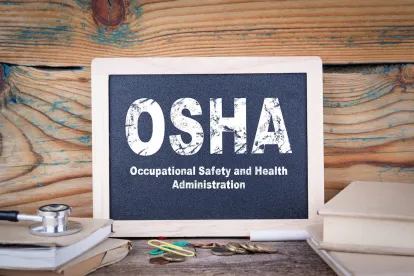Increased enforcement of workplace safety and health regulations is on the horizon and it will not be all about COVID-19. In December, the U.S. Department of Labor updated the Occupational Safety and Health Administration’s (OSHA) Site-Specific Targeting (SST) Directive inspection program, emphasizing recordkeeping requirements.
Additionally, over the past several years, the number of compliance safety and health officers at OSHA decreased. This might change with a new Democrat-controlled Congress and a bigger budget for OSHA that can translate into hiring more compliance safety and health officers to conduct more inspections.
Background
The SST Directive is OSHA’s primary site-specific, programmed inspection initiative targeting general industry, non-construction, workplaces with at least 20 employees. The program directs agency enforcement to establishments with high rates of injuries and illnesses. OSHA selects companies for inspection based on employee injury and illness data reported by employers on Form 300A.
Changes
The revised SST replaces the 2016 SST and is based on data from calendar years 2017-2019. The following changes have been incorporated into the new plan:
-
A new targeting category has been added that uses a three-year data collection range to target sites with consistent injury and illness rate increases during the three-year period; and
-
The scope of an inspection can change from a comprehensive inspection to one that allows a records-only inspections (in limited situations) when a compliance safety and health officer determines incorrect data led to a company’s inclusion in the program. This change ensures OSHA will conduct a full inspection only when the employer has an actual elevated injury and illness rate.
Inspection Criteria
Establishments for inspections are determined randomly. OSHA generates an inspection list based on an upward trend in the “days away, restricted, or transferred” (DART) rates from data submitted by employers in 2017-2019. In addition, establishments that fail to provide OSHA the required Form 300A for three consecutive years will land on a list generated from a random sample of those establishments. OSHA includes non-responding employers to discourage non-compliance.
Inspection Scheduling
The Inspection List is maintained by the Area Office (AO) through the Office of Statistical Analysis. Each AO will have access to software and a database containing the establishments selected for inspection. Using the software, the AO will determine the inspection size (i.e., five to 50 establishments) and allow the database to randomly select and generate a list of establishments to schedule inspections.
Exemptions
OSHA On-Site Consultation Program
An establishment may be granted an exemption from a programmed inspection if it is an approved participant in the Pre-Safety and Health Achievement Recognition Program (SHARP). § 1908.7(b)(4)(i)(B).
Employers that meet all the requirements for recognition and exemption will have the names of their establishments removed from OSHA’s Programmed Inspection Schedule for at least one year. The exemption period starts from the date of issuance of the certificate of recognition.
An On-Site Consultation visit already “in progress” will have priority over a programmed inspection under § 1908.7(b)(1), except as provided in § 1908.7(b)(2) (if any of the following is about to take place: imminent danger investigations, fatality/catastrophe investigations, complaint investigations, or other critical inspections as determined by the Assistant Secretary). If an On-Site Consultation has been scheduled, a programmed inspection may be deferred for up to 90 calendar days.
Voluntary Protection Program (VPP) Applicants
The AO will remove an establishment from the programmed inspection list for up to 75 days when the AO receives notification from the Voluntary Protection Program (VPP) Manager that a VPP on-site review has been scheduled.
In addition, the AO will remove an approved participant in OSHA’s VPP from any programmed inspection list for the duration of VPP participation, unless the establishment chooses otherwise.
Implications
SST inspections are comprehensive or “wall-to-wall.” An AO may open an inspection under this program as a comprehensive safety inspection or health inspection. That determination will be based upon the AO’s prior knowledge of the establishment’s potential hazards. These inspections are intended to be thorough and will look at the entirety of an employer’s operations, equipment, programs, and policies. OSHA often finds some hazard for which to issue citations during one of these comprehensive inspections, particularly if the employer’s DART rate is what got it on the list in the first place. Employers should prepare their worksites for an OSHA SST inspection and consider involving a workplace safety and health lawyer early in the process.
OSHA’s Instruction Directive provides details on the SST inspection plan, identifying key references, describing the inspection list, and providing scheduling and inspection procedures.




 />i
/>i

